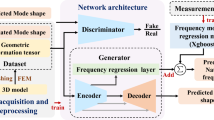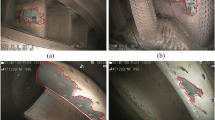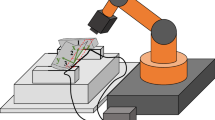Abstract
The near-net-shaped blade is adopted in the aero engine as it’s material-saving and efficient. However, the leading edge shape’s curvature is sharply changed in its machining process and the deformation trend of each cross section has slight differences. Using the traditional machining method is exhausting and time-consuming. Furthermore, it brings more errors during the whole machining process. Therefore, adaptive machining is imported in the machining of the near-net-shaped blade and the leading edge is to be reconstructed during this process. Besides, it is necessary to know whether the reconstructed leading edge is qualified. To address these two issues, a novel approach is proposed to discriminate and classify leading edges. In this paper, we trained a style transform model of generative adversarial networks with theoretical leading edges and used its discriminator network to evaluate the similarity of reconstructed leading edges we had accomplished in our previous work to establish a standard for the qualified reconstructed leading edge. Then, as the curvature of the near-net-shaped blade changes sharply and has complex features, which requires high accuracy of classification, different DenseNet models were adopted to classify whether these reconstructed images are qualified. We experimented on our LDEG dataset and the highest accuracy on the test set was 88.7%. The experiment results demonstrated that the proposed method is effective in evaluating and classifying leading edges in the machining process.









Similar content being viewed by others
Data Availability
The data of this work is included in the article.
References
Makem, J. E., Ou, H., & Armstrong, C. G. (2012). A virtual inspection framework for precision manufacturing of aerofoil components. Computer-Aided Design, 44(9), 858–874. https://doi.org/10.1016/j.cad.2012.04.002
Bremer, C. (2000). Adaptive Strategies for Manufacturing and Repair of Blades and Blisks. Proceedings of the ASME Turbo Expo 2000: Power for Land, Sea, and Air, V1T-V4T. https://doi.org/10.1115/2000-GT-0340
Khameneifar, F., & Feng, H. (2016). A new methodology for evaluating position and orientation errors of airfoil sections. The International Journal of Advanced Manufacturing Technology, 83(5–8), 1013–1023. https://doi.org/10.1007/s00170-015-7641-x
Huang, J., Yuan, Y., Wang, Z., Qi, Z., Xing, C., & Gao, J. (2018). A global-to-local registration and error evaluation method of blade profile lines based on parameter priority. The International Journal of Advanced Manufacturing Technology, 94(9–12), 3829–3839. https://doi.org/10.1007/s00170-017-1125-0
Shi, X., Peng, J., Li, J., Yan, P., & Gong, H. (2019). The iterative closest point registration algorithm based on the normal distribution transformation. Procedia Computer Science, 147, 181–190. https://doi.org/10.1016/j.procs.2019.01.219
Jin, Y., Liao, H., & Pierson, H. (2019). Automatic feature-based point cloud alignment and inspection. Procedia Manufacturing, 39, 484–492. https://doi.org/10.1016/j.promfg.2020.01.405
Chen, X., Tian, G., Wu, J., Tang, C., & Li, K. (2019). Feature-based registration for 3D eddy current pulsed thermography. IEEE Sensors Journal, 19(16), 6998–7004. https://doi.org/10.1109/JSEN.2019.2911699
Várady, T., Martin, R. R., & Cox, J. (1997). Reverse engineering of geometric models—an introduction. Computer-Aided Design, 29(4), 255–268. https://doi.org/10.1016/S0010-4485(96)00054-1
Brujic, D., Ristic, M., & Ainsworth, I. (2002). Measurement-based modification of NURBS surfaces. Computer-Aided Design. https://doi.org/10.1016/S0010-4485(01)00060-4
Ke, Y., Zhu, W., Liu, F., & Shi, X. (2006). Constrained fitting for 2D profile-based reverse modeling. Computer-Aided Design, 38(2), 101–114. https://doi.org/10.1016/j.cad.2005.07.004
Ke, Y., Fan, S., Zhu, W., Li, A., Liu, F., & Shi, X. (2006). Feature-based reverse modeling strategies. Computer-Aided Design, 38(5), 485–506. https://doi.org/10.1016/j.cad.2005.12.002
Khameneifar, F., & Feng, H. (2014). Airfoil profile reconstruction under the uncertainty of inspection data points. The International Journal of Advanced Manufacturing Technology, 71(1–4), 675–683. https://doi.org/10.1007/s00170-013-5527-3
Piegl, L., & Tiller, W. (1997). The Nurbs Book. Springer.
Mohaghegh, K., Sadeghi, M. H., & Abdullah, A. (2007). Reverse engineering of turbine blades based on design intent. The International Journal of Advanced Manufacturing Technology, 32(9–10), 1009–1020. https://doi.org/10.1007/s00170-006-0406-9
Mohaghegh, K., Sadeghi, M. H., Abdullah, A., & Boutorabi, R. (2010). Improvement of reverse-engineered turbine blades using construction geometry. The International Journal of Advanced Manufacturing Technology, 49(5–8), 675–687. https://doi.org/10.1007/s00170-009-2409-9
Dong, Y., Zhang, D., Bu, K., Dou, Y., & Wang, W. (2011). Geometric parameter-based optimization of the die profile for the investment casting of aerofoil-shaped turbine blades. The International Journal of Advanced Manufacturing Technology, 57(9–12), 1245–1258. https://doi.org/10.1007/s00170-011-3681-z
Yun, Z., Zhi-Tong, C., & Tao, N. (2015). Reverse modeling strategy of aero-engine blade based on design intent. International journal of advanced manufacturing technology, 81(9–12), 1781–1796. https://doi.org/10.1007/s00170-015-7232-x
Li, Y., & Ni, J. (2009). Constraints based nonrigid registration for 2d blade profile reconstruction in reverse engineering. Journal of Computing and Information Science in Engineering, 9(3), 31005.
Yilmaz, O., Gindy, N., & Gao, J. (2010). A repair and overhaul methodology for aeroengine components. Robotics and Computer-Integrated Manufacturing, 26(2), 190–201. https://doi.org/10.1016/j.rcim.2009.07.001
Zhao, Z., Fu, Y., Liu, X., Xu, J., Wang, J., & Mao, S. (2017). Measurement-based geometric reconstruction for milling turbine blade using free-form deformation. Measurement, 101, 19–27. https://doi.org/10.1016/j.measurement.2017.01.009
Yazhou, F., Junxue, R., & Yongshou, L. (2018). Prediction and reconstruction of edge shape in adaptive machining of precision forged blade. The International Journal of Advanced Manufacturing Technology, 96(5–8), 2355–2366. https://doi.org/10.1007/s00170-018-1771-x
Wu, D., Wang, H., Zhang, K., Zhao, B., & Lin, X. (2020). Research on adaptive CNC machining arithmetic and process for near-net-shaped jet engine blade. Journal of Intelligent Manufacturing, 31(3), 717–744. https://doi.org/10.1007/s10845-019-01474-z
Goodfellow, I., Pouget-Abadie, J., Mirza, M., Xu, B., Warde-Farley, D., Ozair, S., Courville, A., et al (2014). Generative Adversarial Nets. Proceedings of the 27th Conference on Neural Information Processing Systems (NIPS), 2672–2682. https://doi.org/10.5555/2969033.2969125
Mirza, M., Osindero, S. (2014, November 6). Conditional Generative Adversarial Nets. arXiv:1411.1784. Retrieved August 13, 2021
Isola, P., Zhu, J., Zhou, T., Efros, A. A. (2017). Image-to-Image Translation with Conditional Adversarial Networks. Proceedings of the 30th IEEE/CVF Conference on Computer Vision and Pattern Recognition (CVPR), 5967–5976. https://doi.org/10.1109/CVPR.2017.632
Zhu, J. (2017). Unpaired Image-to-Image Translation using Cycle-Consistent Adversarial Networks. Proceedings of the 17th IEEE International Conference on Computer Vision (ICCV), 2242–2251. https://doi.org/10.1109/ICCV.2017.244
Choi, Y., Choi, M., Kim, M., Ha, J., Kim, S., Choo, J. (2018). StarGAN: Unified Generative Adversarial Networks for Multi-Domain Image-to-Image Translation. Proceedings of the 31th IEEE/CVF Conference on Computer Vision and Pattern Recognition(CVPR), 8789–8797. https://doi.org/10.1109/CVPR.2018.00916
Hinton, G. H. G. E., & Salakhutdinov, R. S. R. R. (2006). Reducing the dimensionality of data with neural networks. Science, 313(5786), 504–507.
Liu, L., Ouyang, W., Wang, X., Fieguth, P., Jie, C., Liu, X., et al. (2020). Deep learning for generic object detection: a survey international. Journal of Computer Vision. https://doi.org/10.1007/s11263-019-01247-4
Simonyan, K., Zisserman, A. (2014, September 4). Very Deep Convolutional Networks for Large-Scale Image Recognition. arXiv: 1409.1556v6. Retrieved August 13, 2021, from https://arxiv.org/abs/1409.1556v6
Kaiming, H., Xiangyu, Z., Shaoqing, R., Jian, S. (2016). Deep Residual Learning for Image Recognition. Proceedings of the 28th IEEE Conference on Computer Vision and Pattern Recognition (CVPR), 770–778. https://doi.org/10.1109/CVPR.2016.90
Huang, G., Liu, Z., van der Maaten, L., Weinberger, K. Q. (2017). Densely Connected Convolutional Networks. Proceedings of the 30th IEEE/CVF Conference on Computer Vision and Pattern Recognition (CVPR), 2261–2269. https://doi.org/10.1109/CVPR.2017.243
Ioffe, S., Szegedy, C. (2015). Batch Normalization: Accelerating Deep Network Training by Reducing Internal Covariate Shift. Proceedings of the 32nd International Conference on International Conference on Machine Learning(ICML), 448–456.
Arjovsky, M., Chintala, S., Bottou, L. (2017, December 6). Wasserstein GAN. arXiv: 1701.07875. Retrieved August 13, 2021, from https://arxiv.org/abs/1701.07875
Gulrajani, I., Ahmed, F., Arjovsky, M., Dumoulin, V., Courville, A. (2017). Improved Training of Wasserstein GANs. Proceedings of the 31st International Conference on Neural Information Processing Systems(NIPS), 5769–5779.
Kingma, D., Ba, J. (2017, January 30). Adam: A Method for Stochastic Optimization. arXiv: 1412.6980v8. Retrieved August 13, 2021, from https://arxiv.org/abs/1412.6980v8
Krizhevsky, A. K. A., Sutskever, I. S. I., Hinton, G. H. G. E. (2012). ImageNet Classification with Deep Convolutional Neural Networks. Proceedings of the 25th International Conference on Neural Information Processing Systems(NIPS), 1097–1105. https://doi.org/10.1145/3065386
Acknowledgements
This work was supported by the National Science and Technology Major Project (Grant number: J2019-VII-0001-0141). We are also grateful to Dr. Hailiang Jin and Yapeng Duan for their technical support.
Funding
This work was supported by the National Science and Technology Major Project, China (Grant No.: J2019-VII-0001–0141).
Author information
Authors and Affiliations
Contributions
Zikai Yin proposed the concept of this paper and carried out the experiment. Then he finished the draft for the manuscript. Yongshou Liang and Junxue Ren reviewed the draft of this paper and gave some suggestions. All the authors read and approved the final manuscript.
Corresponding author
Ethics declarations
Conflicts of interest
The authors declare that they have no conflict of interests.
Additional information
Publisher's Note
Springer Nature remains neutral with regard to jurisdictional claims in published maps and institutional affiliations.
Rights and permissions
About this article
Cite this article
Yin, Z., Ren, J. & Liang, Y. Classification of blade’s leading edge based on neural networks in adaptive machining of near-net-shaped blade. Int. J. Precis. Eng. Manuf. 22, 1817–1828 (2021). https://doi.org/10.1007/s12541-021-00586-y
Received:
Revised:
Accepted:
Published:
Issue Date:
DOI: https://doi.org/10.1007/s12541-021-00586-y




